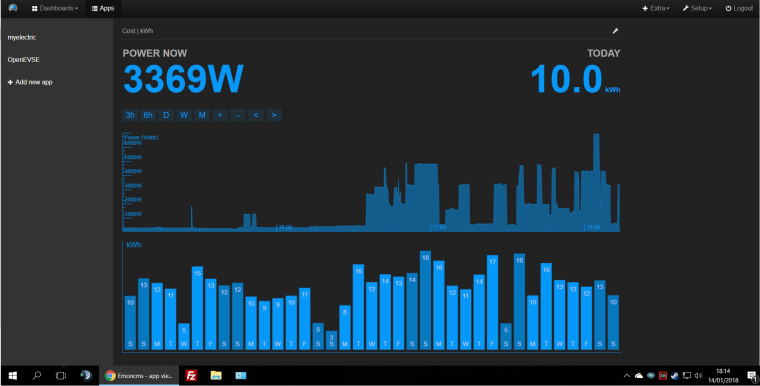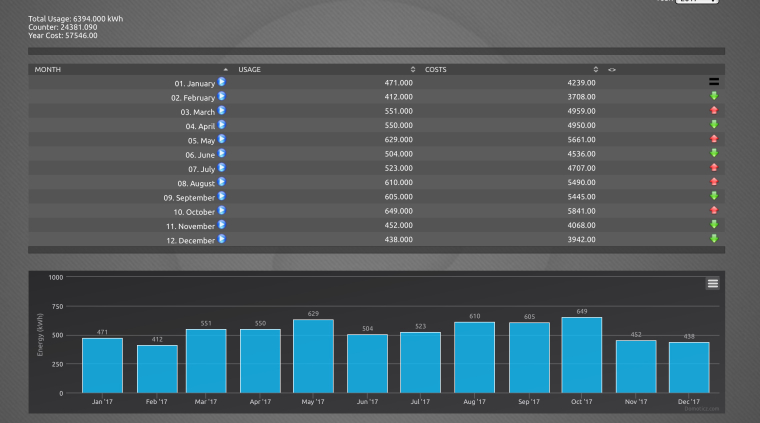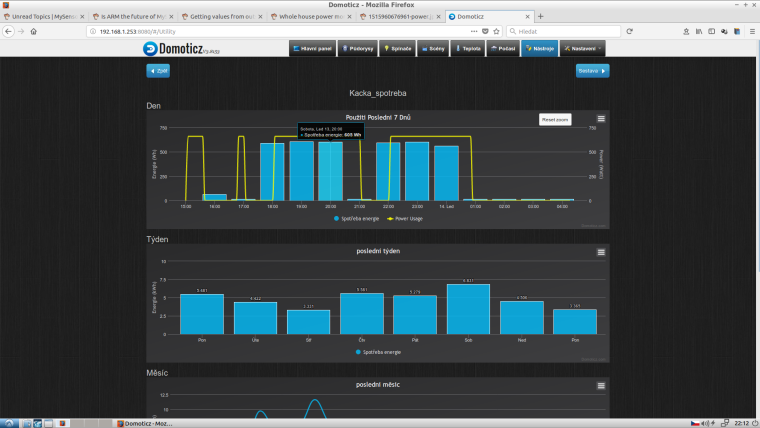Whole house power monitoring.
-
@gohan I don't know, I just pointed out that it may be possible ;)
-
https://openenergymonitor.org/forum-archive/node/58.html then you add the mysensors code for communication.
-
@rozpruwacz Why would want energy harvesting on an energy meter that is actually measuring the mains? You can just use a power supply and you are fine. Anyway, if you want to go DIY look at openenergymonitor site on how to build the sensor
-
@gohan said in Whole house power monitoring.:
Why would want energy harvesting on an energy meter that
I live in building where meter is in a common locker, thus no plugs nor power supplies.
-
@dakipro then you should probably have a breaker box in the apartment, so you could put it there instead
@gohan said in Whole house power monitoring.:
@dakipro then you should probably have a breaker box in the apartment, so you could put it there instead
That's a good idea but it's a bit tight in there :(
-
@gohan said in Whole house power monitoring.:
@dakipro then you should probably have a breaker box in the apartment, so you could put it there instead
That's a good idea but it's a bit tight in there :(
-
I'm using an arduino pro mini with an W500 Ethernet module connected directly to router,and a clamp from ebay(100amps i think). arduino and w500 fits inside a small box and its inside main power box,clamped to the main wire from main eletric deferential . I have the (ATI) Telecomonication box at side of power box so its easy to connect to the router. i dont use transformer for volt read,just read Amps because my power its very stable at 230/235v and this is just for " power waste "control
on first moth that i build it i saved 30€/moth in power(i not a commercial advertisement :P ).i had the electric resistance from water solar heating panel (3000w) working during the night,useless because we don't need hot water in morning,only at end of the day. so now i have another arduino that handle the hot water if there is no enough sun during the day... ( arduino pro minifor the win!!!:+1: )
This is a screenshot from my emoncms page. like you see my wife its doing cakes and dinner,and the oven and induction plate eat a lot of power 
-
@gohan said in Whole house power monitoring.:
https://openenergymonitor.org/forum-archive/node/58.html then you add the mysensors code for communication.
+1 to that
I have been using a single clamp sensor on my neutral at the power meter (SCT-030) hooked to an arduino/ESP8266
It's been working great close to 3 years now with an accuracy of +- 7%
I even use the readings to detect brown-outs and trigger devices to original state after power flips back to mains from the back-up (I live in an area where brown-outs , or power-cuts as we call them , are quite common)

-
+/-7% is good, because Domoticz has it own error -8% when energy consumption calculation is done by Domoticz.
When I send 660 W constantly a few hours, I obtain energy consumption 604 - 609 Wh in this interval :o(
They do not add last 5 min energy consumption in one hour interval ( Argument - because data arrived not at xx:00:00 but XX:00:05 )
Look at Domoticz forum about this bug, if interested.
Boys from Domoticz said - it is not important ....
-
+/-7% is good, because Domoticz has it own error -8% when energy consumption calculation is done by Domoticz.
When I send 660 W constantly a few hours, I obtain energy consumption 604 - 609 Wh in this interval :o(
They do not add last 5 min energy consumption in one hour interval ( Argument - because data arrived not at xx:00:00 but XX:00:05 )
Look at Domoticz forum about this bug, if interested.
Boys from Domoticz said - it is not important ....
-
+/-7% is good, because Domoticz has it own error -8% when energy consumption calculation is done by Domoticz.
When I send 660 W constantly a few hours, I obtain energy consumption 604 - 609 Wh in this interval :o(
They do not add last 5 min energy consumption in one hour interval ( Argument - because data arrived not at xx:00:00 but XX:00:05 )
Look at Domoticz forum about this bug, if interested.
Boys from Domoticz said - it is not important ....
-
@kimot yeah, 5 minutes intervals are not the best for that kind of statistics; you'd probably better look at influxDB for more accurate statistics
@gohan Agreed that the Domoticz 5 minute sample frequency is inadequate for any accurate measurement, there was talk on the forums that this was to change to accurate time based series for the next version of Domoticz, how true that was and when this might appear is unknown.
I wasn't aware of that flaw @kimot, quite a curiosity...
I was pointed to NodeRed previously as a mechanism to duplicate the data stream and accurately record time-based data from pulse meters while passing on the data to Domoticz, I just haven't waded into the thrills of NodeRed yet.
Agreed that clamp meters are easier to install, when I was looking into them, many specifications show an average range of accuracy, but also read elsewhere that this accuracy is not linear, and becomes in reality quite inaccurate at low currents, I cannot recall the error %age.
-
@gohan Agreed that the Domoticz 5 minute sample frequency is inadequate for any accurate measurement, there was talk on the forums that this was to change to accurate time based series for the next version of Domoticz, how true that was and when this might appear is unknown.
I wasn't aware of that flaw @kimot, quite a curiosity...
I was pointed to NodeRed previously as a mechanism to duplicate the data stream and accurately record time-based data from pulse meters while passing on the data to Domoticz, I just haven't waded into the thrills of NodeRed yet.
Agreed that clamp meters are easier to install, when I was looking into them, many specifications show an average range of accuracy, but also read elsewhere that this accuracy is not linear, and becomes in reality quite inaccurate at low currents, I cannot recall the error %age.
@zboblamont said in Whole house power monitoring.:
Agreed that clamp meters are easier to install, when I was looking into them, many specifications show an average range of accuracy, but also read elsewhere that this accuracy is not linear, and becomes in reality quite inaccurate at low currents, I cannot recall the error %age.
But probably it's not a big issue if you have 30% or more (no idea of the real numbers) of inaccuracy at low current, as long as you're much closer at high current which make the bulk of your power consumption ?
-
@zboblamont said in Whole house power monitoring.:
Agreed that clamp meters are easier to install, when I was looking into them, many specifications show an average range of accuracy, but also read elsewhere that this accuracy is not linear, and becomes in reality quite inaccurate at low currents, I cannot recall the error %age.
But probably it's not a big issue if you have 30% or more (no idea of the real numbers) of inaccuracy at low current, as long as you're much closer at high current which make the bulk of your power consumption ?
@nca78 Possibly that would be one approach, but there are so many other effects on CTs as opposed to direct reading meters, proximity of adjacent cable, temperature, humidity, etc., all introducing errors on top of it's spec and how well it is QC'd at manufacture.
Industrial 50A clamps can work down to 0.125A with 2.5% error, the typical 100A domestic variety would not get close I suggest.
Don't misunderstand my comments, where it is impossible to install direct reading meters I see the necessity, just cautioning that they are by nature a compromise.
-
@nca78 Possibly that would be one approach, but there are so many other effects on CTs as opposed to direct reading meters, proximity of adjacent cable, temperature, humidity, etc., all introducing errors on top of it's spec and how well it is QC'd at manufacture.
Industrial 50A clamps can work down to 0.125A with 2.5% error, the typical 100A domestic variety would not get close I suggest.
Don't misunderstand my comments, where it is impossible to install direct reading meters I see the necessity, just cautioning that they are by nature a compromise.
-
@zboblamont just for clarification, what do you mean by "direct reading "?
@gohan Sorry for any confusion, I meant in-line meters, where there is direct reading of voltage, current, pf, etc....
-
@gohan Sorry for any confusion, I meant in-line meters, where there is direct reading of voltage, current, pf, etc....
